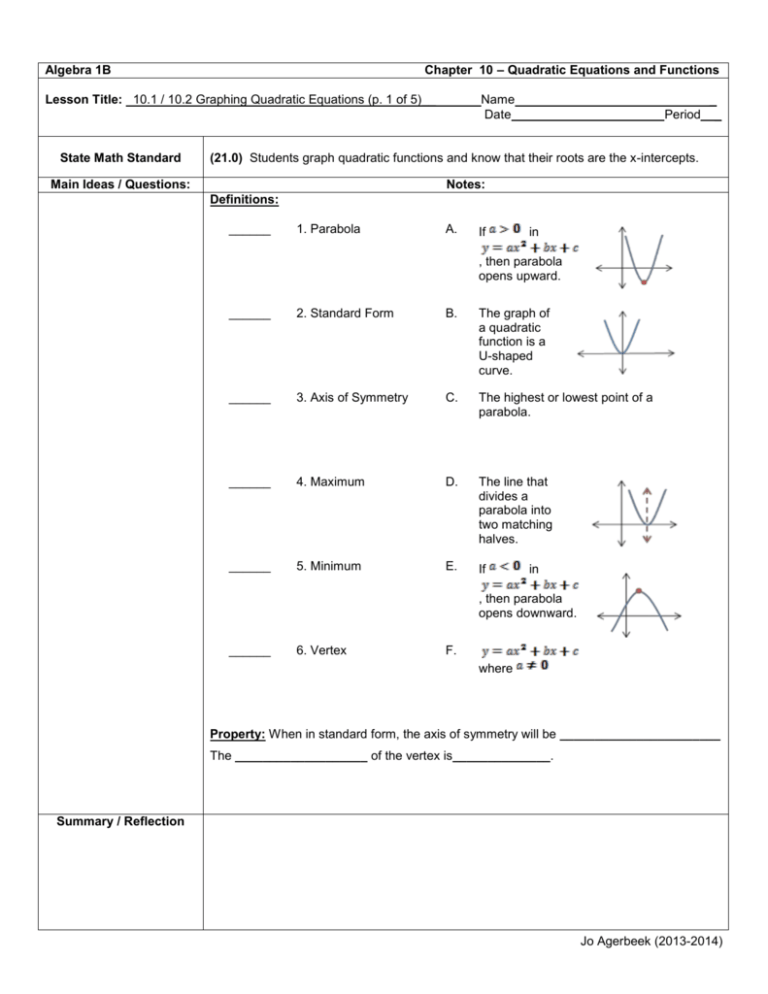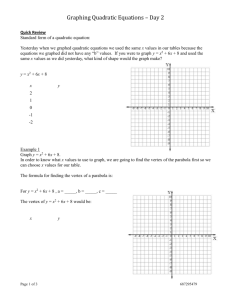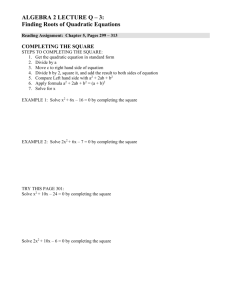Algebra 1B Chapter 10 * Quadratic Eq
advertisement

Chapter 10 – Quadratic Equations and Functions Algebra 1B Lesson Title: 10.1 / 10.2 Graphing Quadratic Equations (p. 1 of 5)__ State Math Standard Name Date Period _ _ (21.0) Students graph quadratic functions and know that their roots are the x-intercepts. Main Ideas / Questions: Notes: Definitions: ______ 1. Parabola A. If in , then parabola opens upward. ______ 2. Standard Form B. The graph of a quadratic function is a U-shaped curve. ______ 3. Axis of Symmetry C. The highest or lowest point of a parabola. ______ 4. Maximum D. The line that divides a parabola into two matching halves. ______ 5. Minimum E. If in , then parabola opens downward. ______ 6. Vertex F. where Property: When in standard form, the axis of symmetry will be _______________________ The ___________________ of the vertex is______________. Summary / Reflection Jo Agerbeek (2013-2014) Chapter 10 – Quadratic Equations and Algebra 1B Functions Lesson Title: 10.1 / 10.2 Graphing Quadratic Equations (p. 2 of 5)__ Name Date _ Period _ State Math Standard (21.0) Students graph quadratic functions and know that their roots are the x-intercepts. Main Ideas / Questions: Notes: Graphing 1. Label: __________________________________________________________ 2. Axis of Symmetry: ________________________________________________ 3. Vertex: _________________________________________________________ x-coordinate:_____________________________________________________ y-coordinate: _____________________________________________________ 4. Tables of Values: __________________________________________________ 5. Corresponding points: ______________________________________________ Example: 1. Label: ___________________________________ 2. Axis of Symmetry: _________________________ 3. Vertex: __________________________________ x-coordinate: _____________________________ y-coordinate: ____________________________ 4. Tables of Values:__________________________ 5. Corresponding points: ______________________ Example: 1. Label: ___________________________________ 2. Axis of Symmetry: _________________________ 3. Vertex: __________________________________ x-coordinate: _____________________________ y-coordinate: _____________________________ 4. Tables of Values:__________________________ 5. Corresponding points: ______________________ Summary / Reflection Jo Agerbeek (2013-2014) Chapter 10 – Quadratic Equations and Functions Algebra 1B Lesson Title: 10.1 / 10.2 Graphing Quadratic Equations (p. 3 of 5)__ State MathStandard Name Date Period _ _ (21.0) Students graph quadratic functions and know that their roots are the x-intercepts. Main Ideas / Questions: Notes: Example: 1. Label: ___________________________________ 2. Axis of Symmetry: _________________________ 3. Vertex: __________________________________ x-coordinate: _____________________________ y-coordinate: _____________________________ 4. Tables of Values:__________________________ 5. Corresponding points: ______________________ Example: 1. Label: ___________________________________ 2. Axis of Symmetry: _________________________ 3. Vertex: __________________________________ x-coordinate: _____________________________ y-coordinate: _____________________________ 4. Tables of Values:__________________________ 5. Corresponding points: ______________________ Example: 1. Label: ___________________________________ 2. Axis of Symmetry: _________________________ 3. Vertex: __________________________________ x-coordinate: _____________________________ y-coordinate: _____________________________ 4. Tables of Values:__________________________ 5. Corresponding points: ______________________ Summary / Reflection Jo Agerbeek (2013-2014) Chapter 10 – Quadratic Equations and Functions Algebra 1B Lesson Title: 10.1 / 10.2 Graphing Quadratic Equations (p. 4 of 5)__ State Math Standard Main Ideas / Questions: Name Date Period _ _ (21.0) Students graph quadratic functions and know that their roots are the x-intercepts. Notes: Example: 1. Label: ___________________________________ 2. Axis of Symmetry: _________________________ 3. Vertex: __________________________________ x-coordinate: _____________________________ y-coordinate: _____________________________ 4. Tables of Values:__________________________ 5. Corresponding points: ______________________ Example: 1. Label: ___________________________________ 2. Axis of Symmetry: _________________________ 3. Vertex: __________________________________ x-coordinate: _____________________________ y-coordinate: _____________________________ 4. Tables of Values:__________________________ 5. Corresponding points: ______________________ Summary / Reflection Jo Agerbeek (2013-2014) Chapter 10 – Quadratic Equations and Functions Algebra 1B Lesson Title: 10.1 / 10.2 Graphing Quadratic Equations (p. 5 of 5)__ State Math Standard Name Date Period _ _ (21.0) Students graph quadratic functions and know that their roots are the x-intercepts. Main Ideas / Questions: Notes: Hint: If the inequality involves or , _________________________________________. If the inequality involves or , _____________________________________________. Example: 1. Label: ___________________________________ 2. Axis of Symmetry: _________________________ 3. Vertex: __________________________________ x-coordinate: _____________________________ y-coordinate: _____________________________ 4. Tables of Values:__________________________ 5. Corresponding points: ______________________ Example: 1. Label: ___________________________________ 2. Axis of Symmetry: _________________________ 3. Vertex: __________________________________ x-coordinate: _____________________________ y-coordinate: _____________________________ 4. Tables of Values:__________________________ 5. Corresponding points: ______________________ Summary / Reflection Jo Agerbeek (2013-2014) Chapter 10 – Quadratic Equations and Functions Algebra 1B Lesson Title: 10.3 Finding and Estimating Square Roots (p. 1 of 2)__ State Math Standard Name Date Period _ _ (2.4) Use the inverse relationship between raising to a power and extracting the root of a perfect square integer; for an integer that is not square, determine without a calculator the two integers between which its square root lies and explain why. Main Ideas / Questions: Notes: Definition: The number a is a square root of b if ______________. Example: 42 = 16 (-4)2 = 16 ___________________________________________ ___________________________________________ Definitions: ________________ ________________ means the ________________________________. Also called the ________________________________________________. means the ________________________________. Note: ________________________________________________________________. Examples: a. b. d. c. e. f. Properties of: RATIONAL Square Roots Examples IRRATIONAL Square Roots Examples Summary / Reflection Jo Agerbeek (2013-2014) Chapter 10 – Quadratic Equations and Functions Algebra 1B Lesson Title: 10.3 Finding and Estimating Square Roots (p. 2 of 2)__ State Math Standard Name Date Period _ _ (2.4) Use the inverse relationship between raising to a power and extracting the root of a perfect square integer; for an integer that is not square, determine without a calculator the two integers between which its square root lies and explain why. Main Ideas / Questions: Notes: Definition: Perfect squares are _________________________________ 12 ↓ 22 ↓ 32 ↓ 42 ↓ Example: Between what two consecutive numbers is Example: Between what two consecutive integers is Calculator Hint: To find the Example: Find Example: Find 52 ↓ 62 ↓ ? ? , in your calculator press to the nearest hundredth. to the nearest hundredth. Summary / Reflection Jo Agerbeek (2013-2014) Chapter 10 – Quadratic Equations and Functions Algebra 1B Lesson Title: 10.4 Solving Quadratic Equations (p. 1 of 2)__ _______ State Math Standard Name Date Period _ _ (21.0) Students graph quadratic functions and know that their roots are the x-intercepts. Main Ideas / Questions: Notes: Reminder: Standard Form of a Quadratic Equation is ______________________________ Example: Solve by graphing. a. b. c. Note: Solutions to a quadratic equation are found where ____________________________ __________________ Quadratic equations will have _______________________________ Example: Solve by Using Square Roots. a. b. c. d. Summary / Reflection Jo Agerbeek (2013-2014) Chapter 10 – Quadratic Equations and Functions Algebra 1B Lesson Title: 10.4 Solving Quadratic Equations (p. 2 of 2)__ _______ State Math Standard Main Ideas / Questions: Name Date Period _ _ (21.0) Students graph quadratic functions and know that their roots are the x-intercepts. Notes: Example 1: A city is planning a circular duck pond for a new park. The depth of the pond will be 4 ft. Because of water resources, the maximum volume will be 20,000 ft 2. Find the radius of the pond. Use the equation and h is the depth. Draw a picture: , where V is the volume, r is the radius, Solve: Label the variables: Example 2: A city is planning a circular fountain. The depth of the fountain will be 3 ft. The maximum volume will be 1800 ft2. Find the radius of the fountain. Draw a picture: Solve: Label the variables: Summary / Reflection Jo Agerbeek (2013-2014) Chapter 10 – Quadratic Equations and Functions Algebra 1B Lesson Title: 10.5 Factoring to Solve Quadratic Equations (p. 1 of 2)__ State Math Standard Name Date Period _ _ (14.0) Students solve a quadratic equation by factoring or completing the square. Main Ideas / Questions: Notes: Property: For every real number a and b, ________________________________________ Example: If ___________________________, then _______________ or ______________ Example: Solve by Zero-Product Property a. b. c. CHECK: CHECK: CHECK: Example: Solve by Factoring a. b. Summary / Reflection Jo Agerbeek (2013-2014) Chapter 10 – Quadratic Equations and Functions Algebra 1B Lesson Title: 10.5 Factoring to Solve Quadratic Equations (p. 2 of 2)__ State Math Standard Name Date Period _ _ (14.0) Students solve a quadratic equation by factoring or completing the square. Main Ideas / Questions: Notes: Reminder: Standard Form of a Quadratic Equation is ______________________________ Example: Solve by Factoring a. b. c. Example: The diagram shows a pattern for an open-top box. The total area of the sheet of material used to manufacture the box is 288 in.2. The height of the box is 3 in. Therefore, 3-in. X 3-in. squares cut from each corner. Find the dimensions of the box. Draw & Label: Solve: Example: Suppose that a box has a base with a width of x, a length of x + 1, and a height of 2 in. It is cut from a rectangular sheet of material with an area of 182 in. 2. Find the dimensions of the box. Draw & Label: Solve: Summary / Reflection Jo Agerbeek (2013-2014) Chapter 10 – Quadratic Equations and Functions Algebra 1B Lesson Title: 10.6 Completing the Square (p. 1 of 2)__ ___________ Name Date Period _ _ (14.0) Students solve a quadratic equation by factoring or completing the square. State Math Standard Main Ideas / Questions: Notes: Definitions: Completing the Square: another way to ______________________________. It is more efficient than ___________, _______________, and ___________. Works _______ time! Perfect Square: Perfect Square Trinomial: Example: Find the n that makes x2 + 22x + n a perfect square trinomial. Example: Find the n that makes x2 – 12x + n a perfect square trinomial. Example: Solve x2 + bx = c a. x2 + 9x = 136 b. m2 – 6m = 247 Summary / Reflection Jo Agerbeek (2013-2014) Chapter 10 – Quadratic Equations and Functions Algebra 1B Lesson Title: 10.6 Completing the Square (p. 2 of 2)__ ___________ State Math Standard Name Date Period _ _ (14.0) Students solve a quadratic equation by factoring or completing the square. Main Ideas / Questions: Notes: Example: Solve a. x2 x2 + bx + c = 0 – 20x + 32 = 0 b. x2 + 5x + 3 = 0 Example: Solve ax2 + bx = c a. 2k2 + 4k = 10 b. 3x2 + 12x = 24 Summary / Reflection Jo Agerbeek (2013-2014) Chapter 10 – Quadratic Equations and Functions Algebra 1B Lesson Title: 10.7 Using the Quadratic Formula (p. 1 of 2)_________ State Math Standard Main Ideas / Questions: Name Date Period _ _ (19.0) Students know the quadratic formula and are familiar with its proof by completing the square. (20.0) Students use the quadratic formula to find the roots of a second-degree polynomial and to solve quadratic equations Notes: Write the Standard Form of a quadratic equation. Solve for x by completing the square. Example 1: Solve x2 + 6 = 5x Example 2: Solve x2 – 2x – 8 = 0 Summary / Reflection Jo Agerbeek (2013-2014) Chapter 10 – Quadratic Equations and Functions Algebra 1B Lesson Title: 10.7 Using the Quadratic Formula (p. 2 of 2)_________ State Math Standard Main Ideas / Questions: Name Date Period _ _ (19.0) Students know the quadratic formula and are familiar with its proof by completing the square. (20.0) Students use the quadratic formula to find the roots of a second-degree polynomial and to solve quadratic equations Notes: Example 3: Solve x2 – 4x = 117 Example 4: Solve -3x2 +5x – 2 = 0. Round to the nearest hundredths. Example 5: Solve 7x2 – 2x = 8. Round to the nearest hundredths. Summary / Reflection Jo Agerbeek (2013-2014) Chapter 10 – Quadratic Equations and Functions Algebra 1B Lesson Title: 10.8 Using the Discriminant (p.1 of 1)_______________ State Math Standard Name Date Period _ _ (22.0) Students use the quadratic formula or factoring techniques or both to determine whether the graph of a quadratic function will intersect the x-axis in zero, one, or two points. Main Ideas / Questions: Notes: Reminder: Quadratic equations can have _______, _______, or _______ solutions. Definition: The expression for the Discriminant is ____________________. It helps you determine ________________________________________________________________. y = x2 – 6x + 3 y = x2 – 6x + 9 y = x2 – 6x + 12 Find the Discriminant: Find the Discriminant: Find the Discriminant: Property of the Discriminant: If ________________________, then there are _______ solutions. If ________________________, then there are _______ solutions. If ________________________, then there are _______ solutions. Example: Find the number of solutions of: 1. 3x2 – 5x – 1 = 0 2. x2 = 2x – 3 3. x2 + 8x + 16 = 0 4. 5x2 + 8 = – 2x Summary / Reflection Jo Agerbeek (2013-2014) Jo Agerbeek (2013-2014)









